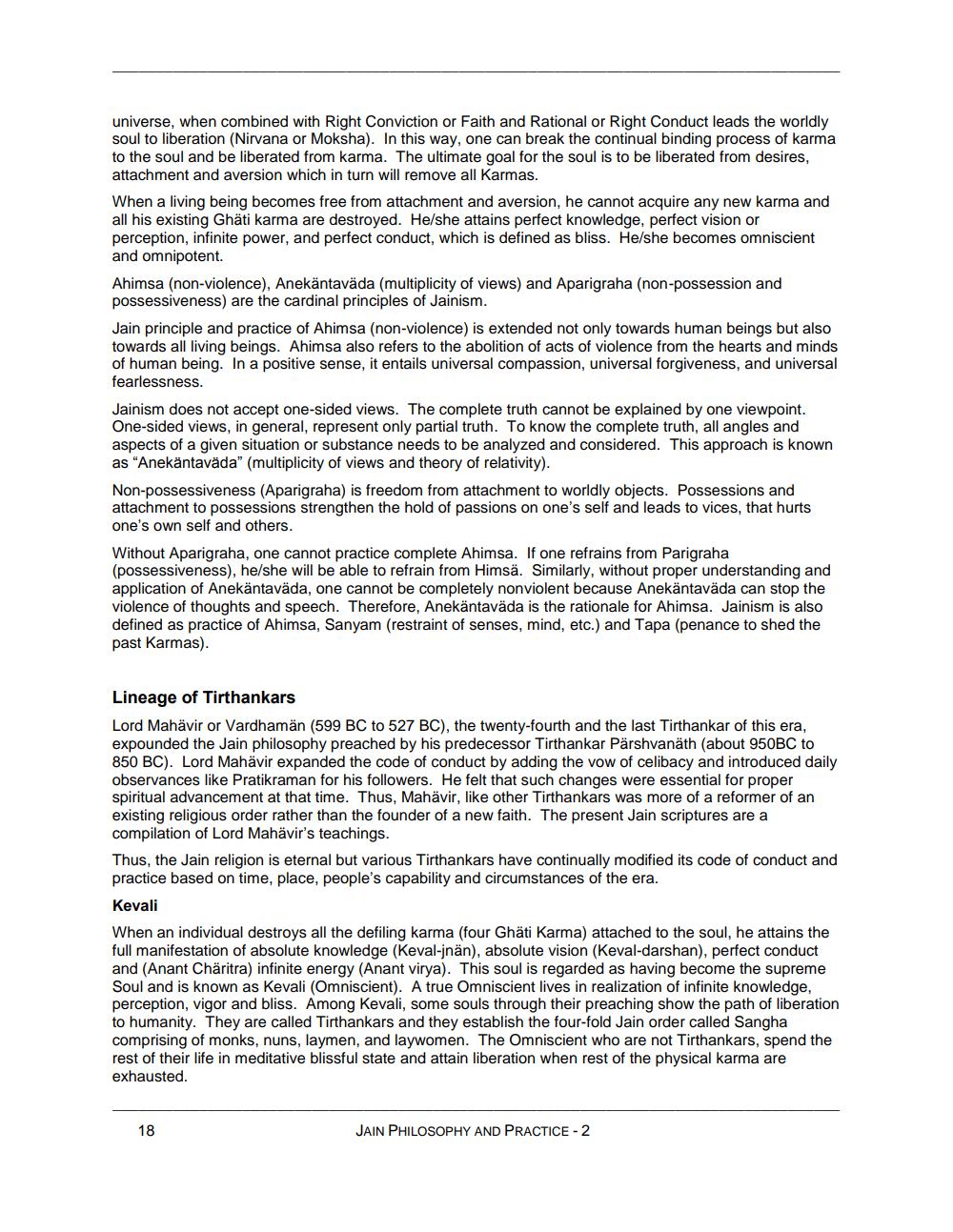________________
universe, when combined with Right Conviction or Faith and Rational or Right Conduct leads the worldly soul to liberation (Nirvana or Moksha). In this way, one can break the continual binding process of karma to the soul and be liberated from karma. The ultimate goal for the soul is to be liberated from desires, attachment and aversion which in turn will remove all Karmas. When a living being becomes free from attachment and aversion, he cannot acquire any new karma and all his existing Ghäti karma are destroyed. He/she attains perfect knowledge, perfect vision or perception, infinite power, and perfect conduct, which is defined as bliss. He/she becomes omniscient and omnipotent. Ahimsa (non-violence), Anekantaväda (multiplicity of views) and Aparigraha (non-possession and possessiveness) are the cardinal principles of Jainism. Jain principle and practice of Ahimsa (non-violence) is extended not only towards human beings but also towards all living beings. Ahimsa also refers to the abolition of acts of violence from the hearts and minds of human being. In a positive sense, it entails universal compassion, universal forgiveness, and universal fearlessness. Jainism does not accept one-sided views. The complete truth cannot be explained by one viewpoint. One-sided views, in general, represent only partial truth. To know the complete truth, all angles and aspects of a given situation or substance needs to be analyzed and considered. This approach is known as "Anekäntaväda" (multiplicity of views and theory of relativity). Non-possessiveness (Aparigraha) is freedom from attachment to worldly objects. Possessions and attachment to possessions strengthen the hold of passions on one's self and leads to vices, that hurts one's own self and others. Without Aparigraha, one cannot practice complete Ahimsa. If one refrains from Parigraha (possessiveness), he/she will be able to refrain from Himsä. Similarly, without proper understanding and application of Anekantavada, one cannot be completely nonviolent because Anekäntaväda can stop the violence of thoughts and speech. Therefore, Anekantaväda is the rationale for Ahimsa. Jainism is also defined as practice of Ahimsa, Sanyam (restraint of senses, mind, etc.) and Tapa (penance to shed the past Karmas).
Lineage of Tirthankars Lord Mahävir or Vardhamän (599 BC to 527 BC), the twenty-fourth and the last Tirthankar of this era, expounded the Jain philosophy preached by his predecessor Tirthankar Pärshvanath (about 950BC to 850 BC). Lord Mahävir expanded the code of conduct by adding the vow of celibacy and introduced daily observances like Pratikraman for his followers. He felt that such changes were essential for proper spiritual advancement at that time. Thus, Mahävir, like other Tirthankars was more of a reformer of an existing religious order rather than the founder of a new faith. The present Jain scriptures are a compilation of Lord Mahävir's teachings. Thus, the Jain religion is eternal but various Tirthankars have continually modified its code of conduct and practice based on time, place, people's capability and circumstances of the era. Kevali When an individual destroys all the defiling karma (four Ghäti Karma) attached to the soul, he attains the full manifestation of absolute knowledge (Keval-jnän), absolute vision (Keval-darshan), perfect conduct and (Anant Charitra) infinite energy (Anant virya). This soul is regarded as having become the supreme Soul and is known as Kevali (Omniscient). A true Omniscient lives in realization of infinite knowledge, perception, vigor and bliss. Among Kevali, some souls through their preaching show the path of liberation to humanity. They are called Tirthankars and they establish the four-fold Jain order called Sangha comprising of monks, nuns, laymen, and laywomen. The Omniscient who are not Tirthankars, spend the rest of their life in meditative blissful state and attain liberation when rest of the physical karma are exhausted.
18
JAIN PHILOSOPHY AND PRACTICE -2




